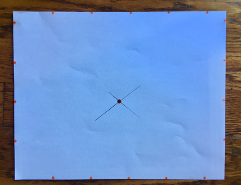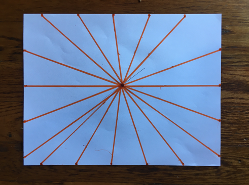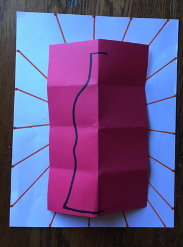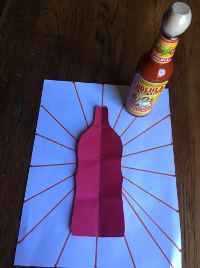Using popular sauces, drink labels, and Andy Warhol as inspiration, students will create bold Pop Art posters while learning about radial symmetry. Recommended for 3rd Graders.
Color: the way the eye perceives light. Organized in a color wheel with the most highly contrasting colors(complementary colors) opposite each other. Complementary colors are red/green, blue/orange and yellow/violet. Intensity refers to the brightness of a color.
Line defined by a point moving in space. Lines show movement, define objects and show texture. Radial Lines are lines that move from the center of the composition to the edges in a pattern. Spokes in a wheel, flower petals, ribs in an open umbrella or a round pizza cut in equal triangles are examples of radial lines. In this lesson they radiate from the central bottle image.
Shape: two-dimensional, flat figure, limited to height and width.
Balance: the arrangement of the elements in an equal distribution of visual weight throughout. In this lesson symmetrical balance is used, so that both sides are a mirror image, with the bottle in the center.
Contrast: the use of opposite elements to create visual interest, excitement and drama. In this lesson colors are contrasted.
Emphasis (Focal Point): where the eye naturally travels first. In this lesson it is the bottle, with the label being the true emphasis since it contains writing or a central shape of its own. Contrasting colors, shape and central placement in a symmetrical design make emphasis happen here.
Repetition: repeated use of elements of visual arts to create a pattern, movement, rhythm, or unity.
Unity: all parts of the composition fit together, creating a sense of peace and completeness. In this lesson, the symmetrical lines and colors in the background create unity.
Graphic Design: the profession of visual communication that combines images, words and ideas to convey information to an audience, especially to produce a specific effect, such as buying the image.
Craftsmanship: when something has been very carefully and neatly made by someone experienced in a medium
Pop Art is mid-20th century art movement that uses familiar images from popular culture as fine art. First emerging in the 1950s, Pop Art was inspired by the major role that mass media began to play in modern life. From magazines ads to advertisements on billboards to comic books, food packaging and record covers, the world was filling up with images fascinating the Pop Artists. Pop Art spans a variety of media, including painting, silkscreen on fabric, photography, film and sculpture.
A pioneer of Pop Art, Andy Warhol (1928-1987) was born and raised in Pittsburg, Pa. He initially pursued a successful career as a commercial illustrator but after exhibiting his work in several galleries in the late 1950s, he began to receive recognition as an influential and controversial artist. His New York studio, The Factory, became a well-known gathering place that brought together distinguished intellectuals, drag queens, models, play-wrights, Bohemian street people, Hollywood celebrities, and wealthy patrons. In the late 1960s, he managed and produced the experimental rock band The Velvet Underground. He also was an author and founded Interview magazine.
Prepare a short power point presentation on Pop Art with some similar examples of this lesson as done by Andy Warhol.
Ask students ahead of time to bring their favorite pop or condiment bottle, clean and dry. Have back up bottles available in case they forget.
Display examples of Pop Art, specifically work by Andy Warhol.
What did Andy Warhol do for the first time in art? (He treated a simple advertised image as art to be appreciated for itself)
Why do bright colors, large shapes and lines make good advertising? (They enable the viewer to quickly and easily see the emphasized product being sold)
How has advertising changed since then? (computerized printing of posters, electronic and animated ads on the internet, fewer billboards, clothing labels proudly displayed by wearer). Graphic design has rapidly change over the years but some designers still hand make signs.
Students will:
Post the vocabulary words and explain them.
After you go through the discussion points above, pass out art materials.





Lesson written by Amaranta Sandys.
Books: “Who Was Andy Warhol?”, by Kirsten Anderson; “Pop Art: 50 Works of Art You Should Know”, by Gary vanWyk; “Whaam? The Art and Life of Roy Lichtenstein”, by Susan Goldman Rubin.
21st Century Thinking Skills
Thinking flexibly, questioning, creating, innovating, taking responsible risks, goal setting, observing, making connections, comparing, contrasting, determining main idea, finding evidence, determining point of view, decision making, evaluating.
WA State Learning Standards
(VA:Cr1.1.3) a. Elaborate on an imaginative idea.
(VA:Cr1.2.3) a. Apply knowledge of available resources, tools, and technologies to investigate personal ideas through the artmaking process.
(VA:Cr2.1.3) a. Create personally satisfying artwork, using a variety of artistic processes and materials. This happens when students make informed choices and use good craftsmanship.
(VA:Cr2.2.3) a. Demonstrate an understanding of the safe and proficient use of materials, tools, and equipment for a variety of artistic processes.
(VA:Cr3.1.3) a. Elaborate visual information by adding details in an artwork to enhance emerging meaning.
(VA:Pr6.1.3) a. Identify and explain how and where different cultures record and illustrate stories and history of life through art. This happens if students can identify characteristics and examples of Pop Art.
(VA:Re7.1.3) a. Speculate about processes an artist uses to create a work of art. This happens if students see various examples of media used to make Pop Art.
(VA:Re7.2.3) a. Determine messages communicated by an image.
(VA:Re8.1.3) a. Interpret art by analyzing use of media to create subject matter, characteristics of form, and mood. This happens when discussing how specific kinds of graphic design sold products.
(VA:Re9.1.3) a. Evaluate an artwork based on given criteria. Did students meet the learning objectives?
(VA:Cn11.1.3) a. Recognize that responses to art change depending on knowledge of the time and place in which it was made.
Arts Integration Opportunities
Writing: Procedural, as in repeating steps for this project.
Spelling: Vocabulary words and their definitions.
Social Studies: Write about how graphic design was used in mid- 20th century, and how it changed when Pop Artists used it in their work.
Please note: These lesson plans are intended for non-profit use only. Use of these plans for commercial purposes should give attribution to the Issaquah Schools Foundation and be accompanied by a nominal donation at www.isfdn.org/donate. Thank you.
Fueling Success for Every Student, Every School